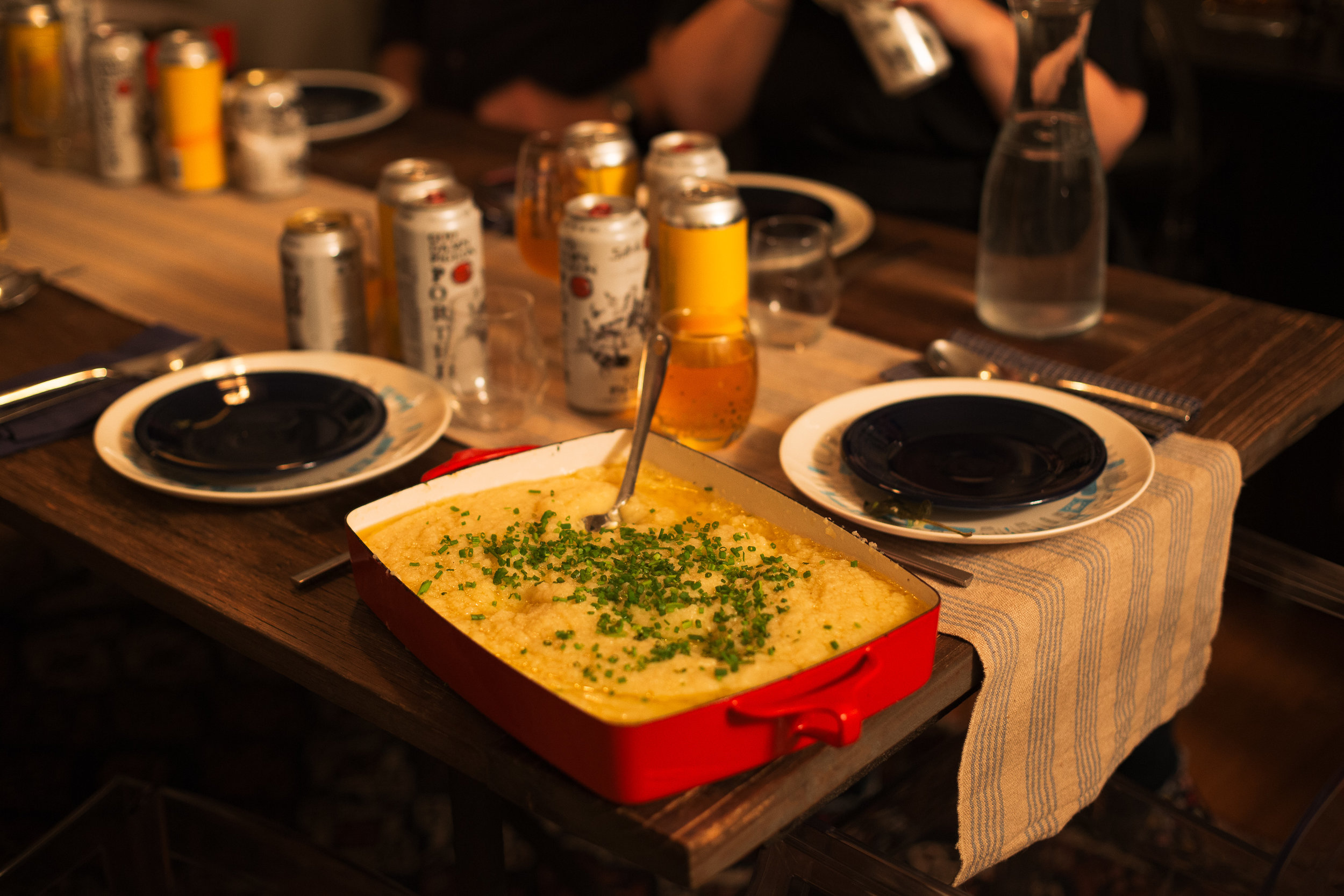Welcome to A Very GBH Thanksgiving. This week, we’re using our Provisions category as an excuse to indulge a’la the season: five courses—soup/salad, vegetable side dish, starch, main dish, dessert—over five days, with some tasty beverages sprinkled along the way.
A pair of our most food-centric writers—one in London, one in Chicago—are teaming up to create this GBH-endorsed Thanksgiving feast. Please enjoy, make it your own, and don’t forget to show some gratitude over the next couple weeks.
—Austin L. Ray, GBH Editorial Director
Course 1: Warm Mushroom Salad and Toasted Corn Husk Soup
Course 2: Roasted Root Vegetables and Collard Greens
Course 3: Challah Bread Pudding and Mashed Butter Potatoes
When I was young, I never understood gravy boats. How could that possibly be enough gravy for a whole table? Did everyone get their own boat? Was the entire gravy boats thing just an expertly crafted long con? It wasn’t until I was much older that I realized my family’s mashed potato consumption was simply not normal.
The normal Spence family holiday plate routine usually breaks down thusly: During the first helping, at least a quarter of the plate is covered with a heaping scoop of mashed potatoes, while the rest of the space is used for the highest priority food options. During the second helping, at least a third of the plate serves as a home to mashed potatoes, while the rest of the plate is reserved for any food that did not make it as part of the first go-around, along with revisited favorites from the initial trip. Finally, the third helping is solely reserved for even more mashed potatoes. The amount ranges from just a tiny scoop to a serving covering damn near half the plate. Then, everyone makes a “tryptophan” joke and passes out from carb overload.
When we wake, it’s time for pie—and maybe a couple more bites of mashed potatoes.
Stuffing is supposed to be the low-key favorite, the side dish that wins hearts and minds, but I never understood the affection. The stuffings I ate throughout my childhood were stodge without comfort. They were mingled dryness and mush, unloving marriages of raisins and celery, plugs designed to steam and disintegrate inside a roasting bird. Stuffing was always best scraped to one side of the plate or surreptitiously scooped into balled-up paper towels and thrown away when the grown-ups weren’t looking.
Perhaps unsurprisingly, then, I come from a place where mashed potatoes are taken very seriously. But we don’t do anything special to them. No roasted garlic, cheese, or other adjuncts—only the expected potatoes, butter, milk, salt, and pepper. The one time I riced the potatoes for a Christmas dinner instead of mashing, I received complaints that the lumps were missing. Why mess with perfection?
I do like to tinker, however. I wanted to try potatoes inspired by Joel Robuchon's puree de pomme recipe. My potatoes would be sharing a plate with my greens and Jerk Turkey. Since there are already a lot of flavors to contend with, I decided to skip the gravy. I wanted to create a simple-but-flavorful side dish, and so I focused on the ingredients.
Bread pudding, though, is another matter. Its name evokes something richer and more indulgent. It is a treat rather than a punishment. The two dishes may be siblings, but one was born with all of the virtues.
As with all bread puddings, whether sweet or savory, this one is made by soaking cubes of bread and other aromatics in a custard of whisked eggs and milk. In place of the plain white bread that is ubiquitous in stuffing recipes, I’ve used eggy challah as a base. This particular custard has also been scented with freshly grated nutmeg and brown butter. (If Thanksgiving isn’t an excuse to add brown butter to every dish, then what is it even for?) The pudding is then baked until crisp and golden on top, while it retains a soft, yielding underbelly.
At a local co-op, I found the freshest Russet potatoes I could. To avoid soupy, pasty potatoes, you need to use a flaky specimen. For me, Russets are the best. I decided to skip the milk usually used in mashed potatoes, instead increasing the amount of butter I use. I hoped that the freshness of the potato would bring enough earthiness and sweetness to counterbalance the butter. As such, I invested in a high-quality butter. I also sought out a premium-quality salt.
I settled on Grey Sea Salt, to add not only seasoning but faint minerality to the final product. This dish would live and die by the quality of the individual components, so each had to be considered carefully.
I boiled the potatoes whole and skin-on. This took a bit longer and made peeling a bit cumbersome, but the skin imparts its flavor to the meat of the potato during the boiling process, and I wanted to collect as much flavor as possible. Similarly, it was necessary that the water was heavily seasoned with the grey salt.
Once the potatoes were done, I set them aside and started melting the butter. I started with a ratio where the amount of butter being used is equal to half the weight of unpeeled potatoes in the recipe. In other words, for the five pounds of potatoes I was using, I would melt two and a half pounds of unsalted butter.
Sage photo by Josh Smith
As a format, bread pudding is highly adaptable. To make this one Thanksgiving appropriate, I’ve added minced sage leaves as well as Cumberland sausages (a geographically protected variety hailing from the north of England), though you can use any herb-forward pork sausage that you’d like. Instead of the dreaded raisins, chopped chestnuts provide a delicate sweetness, and the requisite autumnal association. Fried sage leaves—cooked in more brown butter, natch—are an aromatic garnish.
Claire photo by Josh Smith
If you happen to be pouring a beer as the bread pudding comes out of the oven, you could do far worse than Crooked Stave’s Colorado Wild Sage. It’s lively and lightly tart, and made with Brett, which imparts both funk and rustic complexity. It also features copious quantities of white sage, which makes it a fitting pairing for this particular dish and, odds are, whatever else is on the table. This beer is the Thanksgiving MVP you’ve been seeking.
When seasoning, I knew grey salt would not instantly melt into the mashed potatoes as table salt would. I used this to my advantage and slightly underseasoned them, until right before serving. I wanted to be able to add grey salt right at the end to break up the eating experience. These potatoes were smooth and lush, and I liked the idea of the occasional slight crunch and burst of salty flavor. Finally, I added finely diced scallions because, c’mon, butter, potatoes, and scallions are a goddamn delightful power combo.
Challah Bread Pudding with Sausage, Chestnuts, and Sage
Serves 6
For the bread pudding
1 14 oz (400g) loaf of challah, preferably slightly stale
4 ½ tablespoons (65g) unsalted butter, divided
1 large yellow onion
3 cloves garlic
15 sage leaves
12 oz (340g) pork and sage sausages (or similar)
6 ½ oz (185g) cooked, peeled chestnuts
1 tablespoon olive oil
1 ⅔ cup (400ml) whole milk
3 large eggs
1 teaspoon nutmeg (preferably freshly grated)
1 ½ teaspoons fine sea salt, plus additional
1 teaspoon freshly ground black pepper
For the fried sage leaves
15-20 sage leaves
3 ½ tablespoons (50g) unsalted butter
1. Preheat the oven to 300° Fahrenheit (150° Celsius), and line a large baking sheet with parchment paper or foil. Using a bread knife, slice the challah into roughly 1-inch cubes. Arrange in a single layer on the baking sheet and transfer to the oven. Bake for 15-20 minutes, pausing to flip the bread pieces halfway through, or until well-toasted and beginning to turn golden. Remove from the oven and set aside. Raise the oven heat to 350° Fahrenheit (177° Celsius) and leave to preheat.
2. As the bread toasts, add 3 ½ tablespoons (50g) of the butter to a small frying pan, and place over medium-high heat. Cook for 3-5 minutes, or until the butter has melted, started to foam up, and turned a deep, nutty brown. Stir frequently as it cooks, and watch attentively, as it can quickly go from browned to burned. Once it’s deep amber, immediately remove from the heat and transfer to a bowl. Cover and chill for approximately 30 minutes, or until cool, but not solidified.
3. Prepare the aromatics. Finely dice the onion, and mince the garlic and sage leaves. Remove the sausage meat from the casings and break into small pieces. Roughly chop the chestnuts.
4. Place a large, heavy-bottomed frying pan over medium-high heat and add the olive oil and remaining tablespoon of butter. Once hot, add the onion and cook, stirring frequently, for 5-6 minutes, or until beginning to soften and turn translucent. Add the sausage meat and break up with a wooden spoon. Cook for an additional 4-5 minutes, or until the sausage is no longer pink. Add the garlic, sage, and chestnuts, and cook for 1-2 minutes further. Remove from the heat and leave to cool slightly. Taste and adjust the seasoning if necessary.
5. As the sausage mix cools, make the savory custard. In a medium bowl, whisk together the milk, eggs, and nutmeg. Add the cooled brown butter to the mixture, and whisk to combine. Season with the 1 ½ teaspoons of sea salt and 1 teaspoon of black pepper.
6. In a large bowl, add the toasted challah pieces and the cooled sausage mixture, and toss to combine. Pour over the savory custard and leave the mixture to soak for 10 minutes. Transfer to a large Pyrex casserole/baking dish.
7. Bake in the preheated oven for 25-30 minutes, or until cooked through and golden-brown on top. If it’s browning too quickly, cover with foil as it bakes.
8. While the bread pudding bakes, make your fried sage leaves. Add the butter to a small skillet and place over medium-high heat. As soon as the butter has melted, add the sage leaves in a single layer. Cook for 3-5 minutes, or until the butter has browned and the sage leaves have crisped. Remove from the heat.
9. Top the bread pudding with the sage leaves just prior to serving.
Mashed Butter Potatoes
Serves 6
Ingredients
5 pounds of potatoes
2.5 pounds of butter
Grey sea salt, to taste
1/8 cup of chives
Freshly ground black pepper
1. Scrub potatoes in sink or bowl to remove dirt from outside of potatoes.
2. Fill a pot about halfway with water and bring to a boil. Use as big a pot as you have, so you have enough room to submerge all potatoes.
3. Season boiling water with grey salt. Water should be as salty as sea water. Don’t burn your tongue.
4. Once salted water is at a boil, carefully add potatoes. Boil for 30-45 minutes. Test doneness by removing a potato and sticking a paring knife in the thickest part. When it enters easily, the potato is done.
5. Set boiled potatoes aside to slightly cool. If using same pot, clean and add butter to melt. Stir constantly and do not brown or scorch. Once butter is melted, pull off of heat and set aside.
6. Remove skins from potatoes. They should easily peel off with knife or spoon.
7. If mashing, roughly chop potatoes before adding to butter. Once in butter, slowly mash until potatoes are thoroughly infused with butter. Mash more aggressively as required.
8. If ricing potatoes, add all riced potatoes to the pot, stirring to incorporate butter at the end of the process.
9. Taste potatoes, keeping in mind you will be adding salt right before serving, season to taste. Add freshly ground pepper.
10. Serve immediately or place in a warm oven, covered in foil.
11. Before serving, add salt and top with chopped chive.




















